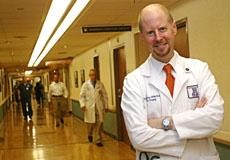The shape of a wound may now provide new insight into how the injury will heal.
According to researchers at the UA’s Southern Arizona Limb Salvage Alliance and La Jolla’s Advanced BioHealing, certain wound shapes seem to heal better than others.
“”This is one piece of a big puzzle,”” said David G. Armstrong, a UA professor of surgery and director of SALSA. “”If a wound is not oval or circular, it most likely will have an unpredictable healing process.””
SALSA is dedicated to healing wounds and preventing amputation in their patients, Armstrong said. The recent research will not only benefit students and doctors, it could teach computerized devices to identify problems that may occur while patients are healing.
“”The machines can trace the wound, we can teach machines to know how,”” Armstrong said. “”It’s going to help improve our batting average. Knowing the shape and its characteristics will help us know the stages of healing, similar to a growth chart.””
Currently there is an amputation in the world every 30 seconds, and Armstrong hopes this technology can help reduce that rate.
SALSA works with mostly chronic wounds, including neuropathy, a disorder of the nerves where infection may occur. Another common wound is a pressure sore, where a sore forms because of continuous pressure as occurs when patients lay in hospital beds for long periods of time.
According to Matt Cardinal, a clinical research scientist of Advanced BioHealing, 3,588 wound tracings of 338 venous leg ulcers were followed during a trial of two wound treatments. The trial determined that the relationship between the size and shape of the wound correlates to wound healing and eventual full wound closure. “”The research we work on is critical in furthering both clinical and scientific understanding of wound healing, particularly in chronic wounds,”” Cardinal said. “”Even with the large number of chronic wounds prevalent in the U.S., there is still a great need for new treatments that may promote fast healing, in order to avoid adverse outcomes from non-healing wounds.””
Their research is trying to challenge clinicians and researchers to think outside the box, he said.
“”If we get more studies to confirm our findings, we have built momentum toward developing an ever-increasing knowledge base on the mechanisms of wound healing,”” Cardinal said. “”If the FDA begins to take notice, we may even influence how wound healing products get approved.””
Recently, the study was published in the March/April edition of Wound Repair and Regeneration.
“”By developing new methods of quantifying wound healing, there’s a chance that a valuable treatment gets identified much sooner and in a more cost-effective manner,”” Cardinal said.









